Vitamin C is one of the most commonly raved about ingredients in skincare, with lots of evidence to back up its effects. But it’s also one of the most confusing. There are just so many different vitamin C ingredients and product types, and this is before you even get to all the different products you can buy!
So this is going to be a bumper guide, and it’s going to have to be split up because there’s just so much to talk about.
In this post I’m going to focus on the form of vitamin C with the best evidence, which also happens to be the fussiest drama queen: ascorbic acid. We’ll go through what it does, the different types of ascorbic acid products, and some product recommendations.
In Part 2, we’ll cover the other versions of vitamin C (the derivatives), which are great if your skin can’t handle ascorbic acid, or if you can’t handle how confusing ascorbic acid is.
Watch the video here on YouTube.
What does vitamin C do?
Why is everyone so obsessed with vitamin C in skincare?
Well, it’s because of the amount of evidence behind it. It’s one of the best studied skincare ingredients! In the Grand Hierarchy of Skincare Active Ingredient Categories, it’s right below retinoids.
And specifically, it’s ascorbic acid that we’re talking about. Ascorbic acid is the best studied and the most common type of vitamin C ingredient on the market. It’s actual vitamin C, the stuff you find in oranges and in supplements.
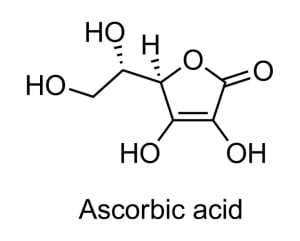
(A side note: sometimes you’ll see people say it has to be L-ascorbic acid, not just regular ascorbic acid. The reality is: pure L-ascorbic acid is the cheapest version you can buy, so all ascorbic acid you get in skincare and supplements is going to be L ascorbic acid.)
Boosting collagen
The most exciting effect that L-ascorbic acid has had in studies is that it can increase collagen in the skin. Vitamin C is involved in making collagen and crosslinking it, so it forms a nice firm network – some of the enzymes that make collagen (prolyl and lysyl hydroxylase) need vitamin C to work.
Ascorbic acid might also be able to block the action of matrix metalloproteinase 1 (MMP-1), an enzyme that breaks down collagen in your skin.
Ascorbic acid can also help with wound healing, such as after fractional laser treatment. It’s been found to reduce downtime, and may also be able to boost pigment reduction.
Reducing pigment
Excess pigment is the other big skin concern that vitamin C can help with, for example with sunspots, or post acne marks (post-inflammatory hyperpigmentation or PIH) or melasma.
Ascorbic acid interferes with the production of melanin, the brown pigment in skin. The exact way it does this is still isn’t entirely confirmed, but so far it looks like it interferes with the enzyme tyrosinase and stops it from doing its job.
Related post: What are the skin lightening alternatives to hydroquinone?
Sun protection
Vitamin C can also protect skin from the sun. It doesn’t stop UV like sunscreen, but it does act as an antioxidant that mops up the damage UV does inside your skin. One of the big reasons UV is bad for skin is because it produces free radicals.
The short version: free radicals are really reactive substances that smash into lots of different parts of your skin and damage it, like a bull in a china shop. Antioxidants can soak up this damage… provided they can get into your skin, where the free radicals form. And ascorbic acid can get in!
Related post: Antioxidants in Skincare: What Do They Do?
In one of the classic vitamin C studies done on pig skin, twice as much UV was needed to turn skin red after it was treated with 15% ascorbic acid, adding 1% vitamin E doubled that, and adding 0.5% ferulic acid doubled that again – this combo gave a total of 8 times the UV protection. There were similar results when vitamin C was used with ferulic acid and phloretin on human skin.
Vitamin C’s also been shown to reduce some of the changes that infrared radiation can cause in skin, and there’s evidence that it can also protect against ozone and diesel engine exhaust, two pollutants you’ll find in urban areas.
It’s worth noting that in some of these studies, people who didn’t get as much vitamin C in their diet had more improvements in their skin, so try to eat a balanced diet as well, it’s good for your skin.
Ascorbic acid product basics
Concentration
Studies have tested ascorbic acid at between 3–25%. Higher percentages are going to be more irritating, and like for many skincare actives, low percentages are underrated.
A lot of studies have been done with 3% and 5% ascorbic acid, so you don’t necessarily need to go very high to see benefits. There are definitely diminishing returns with too much ascorbic acid!
I’d recommend starting at under 10% and working up, or even just staying there or going down if your skin is sensitive to it. A lot of people do find ascorbic acid really irritating!
There are also some fruit extracts are very high in ascorbic acid. For example, around 12% of dried weight of kakadu plum is ascorbic acid. However, extracts are usually used which have varying concentrations of fruit, so you can’t easily work out percentage in the final product. So if you want something more reliable, I’d recommend looking for a product with actual ascorbic acid.
Layering
I’d recommend applying ascorbic acid as close as you can to bare skin since it’s not great at absorbing into skin. Use it as one of the first steps of your routine after cleansing.
Ingredient incompatibilities
Vitamin C is compatible with most things. The only true incompatibilities I can think of are copper ions (e.g. any of those blue copper products) and benzoyl peroxide – both of these will inactivate ascorbic acid.
It’s a myth that you can’t use niacinamide with ascorbic acid (Kind of Stephen has debunked this thoroughly on his blog).
I’d recommend being careful with other irritating ingredients like hydroxy acid exfoliants and retinoids. You can use them together, but if you’re not really careful you’ll probably burn your face off.
I also had an eyebrow pencil that turned an attractive orange red with ascorbic acid. It seems to be due to the blue ferric ammonium ferrocyanide pigment turning colourless after the iron(III) ions are reduced by ascorbic acid, so the complimentary colour (orange) showed through more (thanks to my inorganic chemist colleague Peter for helping me work this out!).

When to use
You can use vitamin C morning or night. In the morning you’ll probably get more of the sun protection benefits, but it’s believed that it can have a depot effect, so one application can last in skin for more than 24 hours (in pig skin it was 72 hours).
It’s a myth that vitamin C is photosensitising. It actually decreases UV sensitivity! (I think this comes from the fact that alpha hydroxy acids are photosensitising, and people assumed that meant all acids were, when in fact most acids aren’t).
Why vitamin C is so confusing
The big problem with vitamin C is that there’s so much variation when it comes to different vitamin C products.
Not all the forms of vitamin C have been shown to have these beneficial effects in studies on human skin. Some of them might’ve had an effect on one study, but it wasn’t very high quality. Some are unlikely to have effects at all. And for pretty much all of them, it depends on the formula.
Here’s where I’m going to introduce the Lab Muffin Matrix for sussing out whether a skincare product works. I’ll talk more about this later, and to be honest I haven’t completely fleshed it out yet.
But basically these are some of the things to think about when deciding if a skincare product has a reasonably good chance of working:
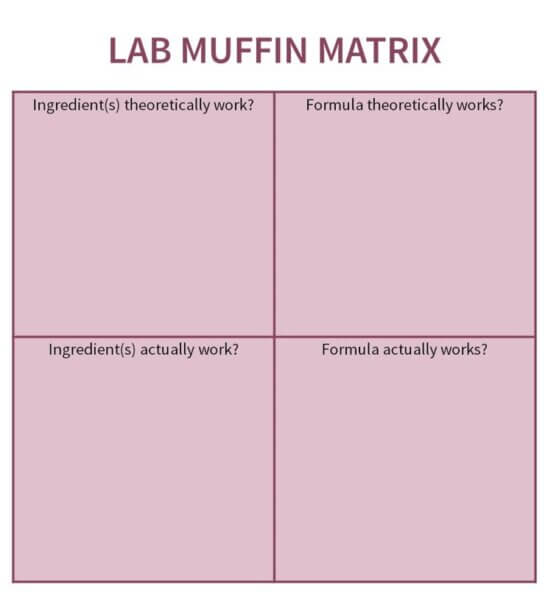
You want to see if the active ingredients in the product can theoretically work (top left), and if the active ingredients have been tested to actually work on skin, such as in clinical trials (bottom left).
A lot of things that could theoretically work really well don’t actually work when you put them on a complex system like a human body. If everything that theoretically worked did actually work, we would have cured cancer thousands of times over.
Related post: Sneaky Marketing? The Inkey List Succinic Acid Acne Treatment
You also want to see if the specific formula of a product could theoretically work (top right) and if the formula’s been actually tested on skin in clinical trials (bottom right).
Some ingredients are very easy to formulate with, so you don’t have to do as much guesswork here. But others are a bit more annoying (cough ascorbic acid).
Problems with ascorbic acid
There are a few really annoying things about L-ascorbic acid.
Instability
Firstly, L-ascorbic acid’s pretty unstable and breaks down into inactive dehydroascorbic acid when it’s ionised. This happens faster in water, at high pH (i.e. more alkaline), and when it’s exposed to light and oxygen (the decomposition reaction is also called oxidation because oxygen’s usually involved). This means your product gets less effective over time, and how quickly this happens depends on the formula.
When it breaks down it turns yellow, then orange, then brown, so you can usually get a visual idea of how active your vitamin C is.
So back to the Lab Muffin Matrix: L-ascorbic acid ticks off the left two boxes really well, with tons of studies (or at least tons by cosmetic skincare ingredient standards). But it’s the other two boxes on the right where things get incredibly dicey – largely because of instability.
Ascorbic acid’s stability depends so much on the formula, packaging, and how long you’ve had the product. It’s probably one of the trickiest ingredients for this part.
Staining
On top of whether or not it works, decomposed ascorbic acid can also just be plain annoying because it stains your skin.
Related post: Why Vitamin C Can Stain Your Skin (and How to Avoid It!)
After the ascorbic acid breaks down a few times, it turns into a chemical called erythrulose, which is actually a component of fake tan. That means your vitamin C product can stain your fingers and face for days, along with temporary skin staining and vivid nail staining from the other yellow/orange/brown decomposition products.
This isn’t harmful, but it’s not designed to be a fake tan product, so it doesn’t go on very evenly. It also smells a bit like metallic soy sauce (which won’t be a surprise if you’ve ever used fake tan).
And the decomposition speeds up after you’ve put it on your skin! Obviously there’s more oxygen and light on your skin than in a bottle, so even a very stable formula can give you nasty yellow fingers for days.
Irritation
It’s also pretty irritating. Ascorbic acid is usually formulated to be at a pretty low acidic pH – below 3.5 – to help it absorb into skin if it’s in a water-based serum. When the pH is higher, more of the ascorbic acid is charged, and charged things generally don’t get into skin as easily (I actually talked about this in my very first YouTube video).
Having a low pH also helps keep it stable. Sometimes, the pH is also lower than it needs to be for legal reasons.
Ascorbic acid product guide
Water-based serums
C E Ferulic Serum
The best researched ascorbic acid formula is unarguably the Skinceuticals C E Ferulic Serum.
The scientist who did most of the research on vitamin C’s effects on skin was Dr Sheldon Pinnell. He patented a particular formulation, and his son started the skincare company Skinceuticals (now owned by L’Oreal). The patent (commonly called the Duke patent) is pretty broad – as well as covering the C E Ferulic formula, which is the formula developed from the studies that found the best known benefits of vitamin C, it covers any formula with:
- L-ascorbic acid
- at 10–20% concentration
- pH 2.0–3.5
So in other words, the formulas where ascorbic acid seems to perform best.
Note that these conditions aren’t hard and fast rules, as they’re often made out to be. A lot of it is really just based on one famous study on pig skin performed under not-entirely-realistic conditions, so it’s possible that other formulas could work just as well. There are indeed clinical studies where lower percentages (3%, 5%) gave good results too.
But this background is why scientists and dermatologists rave about the Skinceuticals formula. C E Ferulic is literally THE product that’s the culmination of all this groundbreaking ascorbic acid research.
It’s really rare to have a non-drug product that ticks all of the boxes on the Lab Muffin Matrix, and this product basically does the best out of all the skincare products that aren’t regulated as drugs.
The other Skinceuticals vitamin C serums also use patented combinations – they’ve replaced the vitamin E with less thick and oily ingredients to make it more suitable for oily skin. There’s Phloretin CF, which is recommended for discolouration, and Silymarin CF, for oily and acne prone skin. And again, there are lots of studies on these products, again getting good marks all over the Matrix.
The obvious downside is that they’re really expensive, and not everyone can afford them, even if they are the gold standard Rolls Royce of vitamin C products / all non-drug skincare products.
And it does still eventually break down, it’s still not entirely stabilised. The brand says it’s fine for 6 months after opening, while the patent suggests it can stay stable for a year.
So let’s talk about the other options…
Copycat serums
You could look for a copycat vitamin C, vitamin E and ferulic acid product.
There are some that violate the patent, and L’Oreal haven’t sued them yet for whatever reason, and there are some that get around it by messing with the formula. For example, some of them go outside of the pH range that Skinceuticals , so they might be even lower than the already irritating low pH (I think that’s why a lot of people think their skin can’t handle vitamin C).
As a scientist who’s been in R&D, I know how important patents are in getting companies to invest in innovation, so I’m a bit ethically conflicted about trying to work out which ones are and aren’t violating the patent.
Instead, I’ll just list a bunch of popular products that are water-based with vitamin C, E and ferulic acid:
- Timeless 20% Vitamin C
- Paula’s Choice C15 Super Booster
- Maelove The Glow Maker
- Geek and Gorgeous C-Glow 15% Vitamin C Serum
- Ausceuticals Vitamin C Serum
I’d recommend that you look up reviews to get a gauge for which ones might be the best option for you.
Are they as good as the Skinceuticals ones? Well, the overall formulas obviously don’t have the same level of evidence.
But anecdotally, people who’ve tried both either find the Skinceuticals much gentler and more effective, or can’t tell the difference. So I think it really depends on how picky your skin is and what you want out of a vitamin C product.
For shorter term effects like pigment, anecdotal evidence is more useful, but longer term effects like collagen production are going to be a lot better supported by clinical evidence, because it’s not really something you can easily see.
Related post: Science vs Anecdotal Evidence and Reviews (with video)
You could also track down the ingredients and DIY something very similar to the Skinceuticals formula by following the patent. (Disclaimer: I am not a lawyer, so this is not legal advice. I am not responsible if L’Oreal break down your door and sue you for patent infringement.)
This is a bit of an investment, both time and money wise, which could pay off if you commit to doing it regularly. So if you’re not sure if your skin even likes vitamin C, it’s probably not as good an idea. If you want to go down this path, Holy Snails has a recipe on her blog.
Serums with other antioxidants
It’s also worth noting that there are lots of antioxidant combinations that work apart from just vitamin E and ferulic acid. This combination is mostly what Dr Pinnell published peer reviewed papers on, which is why so many products stick to it.
But even in the original patent there are a lot of combinations that worked. There are a million antioxidants out there, and they’re not all in the patent!
Ferulic acid is also the main contributor to the hot dog water smell – the vitamin C also contributes, but it’s mostly the ferulic acid. So if the smell really bothers you, it might be worth picking one that doesn’t have ferulic acid.
I’d recommend trying to go for a product from a brand that’s tested it out properly in terms of stability and clinical results, because now the Lab Muffin Matrix is a little sadder on the right side. One example of a good one would be Ultraceuticals Ultra C Firming Serum.
Other stabilising methods
It’s also possible to stabilise water-based ascorbic acid in other ways.
Airtight packaging
You can use special airtight packaging. Unfortunately a lot of airless pumps aren’t truly airless, so they can’t properly protect the ascorbic acid from oxidation.
It’s also difficult to find pumps that don’t have metal springs in them. This is an issue because the metal rusts and dissolves, which means your packaging breaks – plus the dissolved metal makes ascorbic acid decompose faster.
But it’s possible to have custom packaging that works! For example, Rohto Melano CC Essence has a really airtight tube that you have to really squeeze to get drops of product out.
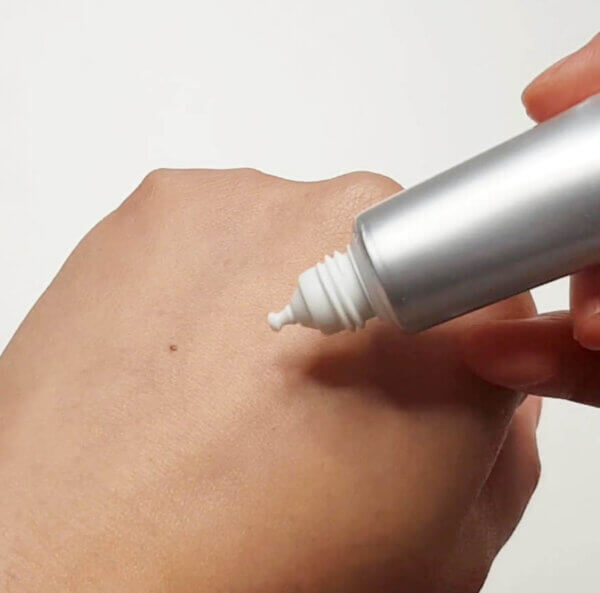
Related post: Reviewing Cult Asian Products (with video)
Colloidal gold particles
You can also use colloidal gold particles. I know gold sounds really gimmicky, but they actually have some really cool applications in drug delivery, which is the science of getting substances where they need to be to work, which is very relevant to skincare. One of my PhD lab mates was studying them!
The ascorbic acid is bonded (the technical term is conjugated) to the outside of tiny gold particles, which are just too big to be categorised as nanoparticles, along with glutathione, another antioxidant. It’s almost like a vitamin C derivative, except it’s still listed as ascorbic acid in the ingredient list. This extra bond stabilises it, and the ascorbic acid doesn’t come off the particles until the whole assembly is absorbed into your skin.
This also means it’s fine at a higher pH – the manufacturer recommends 3.5-6.5. And because it gets into your skin a lot more easily (according to the manufacturer, anyway) and it’s more stable, a lower percentage of gold-conjugated ascorbic acid can be as effective as a higher percentage of regular ascorbic acid.
However, since the gold conjugation fundamentally changes the properties of the ascorbic acid, it’s a bit more lacking in the Lab Muffin Matrix, and it’s akin to a vitamin C derivative in that sense.
Murad Vita-C Glycolic Brightening Serum and Naturium Vitamin C Complex Serum use gold-conjugated ascorbic acid.
There are also vitamin C derivatives, which is a whole different kettle of fish – I’ll go through these in the next part of my vitamin C guide.
Dissolving Ascorbic Acid At Home
So that’s water-based ascorbic acid serums. As I mentioned, ascorbic acid is unstable when it’s dissolved in water in a product. But what if you don’t have water in the product you buy, and you dissolve the ascorbic acid yourself?
This means you don’t have to worry about whether your product’s been sitting around for ages before getting to you, slowly decomposing or possibly going through some pretty gnarly destabilising temperature changes.
There are a few different categories of these products…
Simple DIY serum
There’s the very simple DIY formula I talked about in an older post.
Related post: Easy (5 Minute) DIY Vitamin C Serum Recipe (with video)
The formula is super basic with no penetration enhancers. You should probably remake it every few weeks because it does break down, and the only preservative is the low pH. But because it’s so fresh, some people see better results from this than from older premade vitamin C products. This is the cheapest option, but it does take a fair bit of time.
I’ve had a lot of questions about this DIY serum – some people have claimed that it can’t possibly work, but I don’t think any of the arguments make scientific sense.
- Having the ascorbic acid dissolve or crystallise after you apply it on your skin isn’t a big issue – I’ll talk about this a bit further down, but solid ascorbic acid crystals can work on skin.
- Ascorbic acid can be stable enough for a decent amount to hang around for a couple of weeks after you dissolve it. This has been reported in the literature, and I’ve done some experiments myself to work out how long it lasts, which I’ll talk about in a later post. It’s definitely not all gone in 8 hours.
I’ve also had a lot of questions about adding different things to it, like glycerin and aloe vera. I generally wouldn’t recommend it because there’s no extra preservative. It’s at a very low pH which means there’s minimal microbial risk, but if you add extra stuff that can feed bacteria and fungi it increases the risk, so I’m not really comfortable recommending it. Same with keeping it for a longer period of time – again, it could be fine, but there’s a reasonable chance it’s not. So if you try it be super careful, and don’t say I didn’t warn you.
If you want to make it more complicated, I’d recommend looking at the Holy Snails recipe and tweaking that.
Products that come with separate powder
There are also products where the ascorbic acid comes as a separate, set amount of powder that you dissolve yourself into a base serum after you take it home. Drunk Elephant recently came out with one, and Clinique have done it too.
Mix powder into products right before you apply them
There are also jars of ascorbic acid powder from brands like The Ordinary and Good Molecules. You’re supposed to mix a little bit into your product every time right before you apply it.
Related post: Why I don’t recommend The Ordinary’s Niacinamide and L-Ascorbic Acid powders (with video)
I’ve talked about why I really don’t like these before. You need a really tiny amount per application – 3 drops of a 10% vitamin C serum converts to about 10 mg, which is 1/50th of a Tic Tac. It’s really difficult to measure that out accurately, so you could be applying way too much.
Additionally, when you dissolve the powder without adjusting the pH, it’s probably going to end up at a lower, more irritating pH. So I’d warn against doing that – it might be OK if your skin is really resilient to vitamin C, perhaps on your body, or maybe if you mix it into a really soothing product… but I think there are much safer options that won’t mess up your barrier.
Also if you decide not to listen to me and do it anyway, it’s probably cheaper to buy a jar of ascorbic acid supplement powder and a mortar and pestle.
(All of these powders can also be used to make a DIY serum, which is a lot safer.)
Water-free products
There are also water-free products, which have finely ground up ascorbic acid particles suspended in an oily base. Ascorbic acid doesn’t ionise in oil, so it stays pretty stable in there. Then when you apply it to your skin, it slowly dissolves on your skin in the water that’s always evaporating off your skin (the same water that’s in transepidermal water loss). This is also why so-called “crystallisation” of ascorbic acid isn’t a problem when you have a simple DIY serum – solid ascorbic acid still works on skin!
Ultraceuticals have published a peer reviewed study on what I’m assuming is their Ultra C23+ Firming Concentrate. This has tiny particles of ascorbic acid in a silicone base, and it had a lot of the nice vitamin C effects on human skin samples.
L’Oreal Revitalift 10% Pure Vitamin C Serum is another example (side note: a lot of the time when it’s a big brand like L’Oreal, you can probably assume they’ve tested it for efficacy and stability).
Paula’s Choice and The Ordinary have similar products too. There are a couple of premade ascorbic-acid-in-silicone raw ingredients available that can be used to formulate these sorts of products easily.
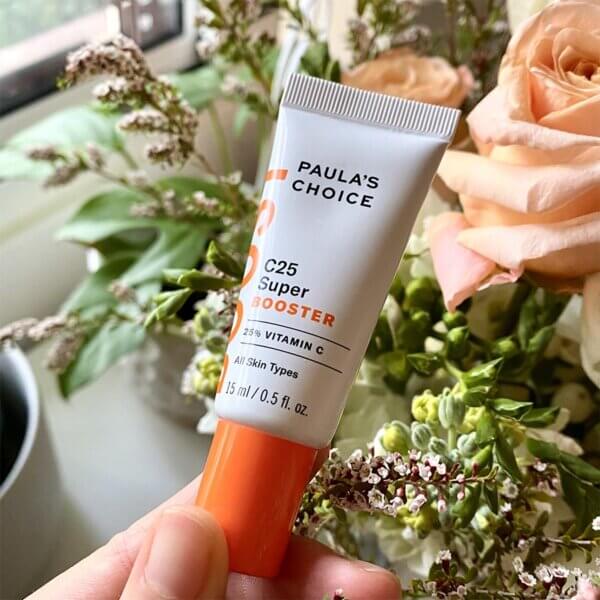
The biggest problem with these is that the ascorbic acid isn’t dissolved yet, and they usually don’t have any pH adjusters in them. So when the little bits of ascorbic acid do dissolve, you end up with tiny, low pH puddles of very concentrated ascorbic acid on your skin. And some people are fine with this, but a lot of people (including me) get stinging and irritation.
To reduce the irritation I like to mix it with another product in my hand before applying it. Paula’s Choice 2% BHA Liquid works well for this but I wouldn’t suggest it if your skin is sensitive because double acid. You can also use a toner.
Even with the mixing, sometimes it’s still too irritating for some people, plus the texture can be tricky (the mixing can also help with this). I wouldn’t recommend these products at all if your skin can’t handle a regular water-based ascorbic acid product. But if your skin can handle them and you want something you can leave in a corner somewhere for a year and still be active, this is a great option.
Microneedle patches
I almost forgot this category (although to be honest, I’ve probably left out a few accidentally) – microneedle patches sometimes have ascorbic acid in the solid needles. After you apply the patch, the microneedles go deeper into your outer skin layers and dissolve.
Related post: Guide to Acne Patches: Hydrocolloid, Treatment, Microneedle (Video)
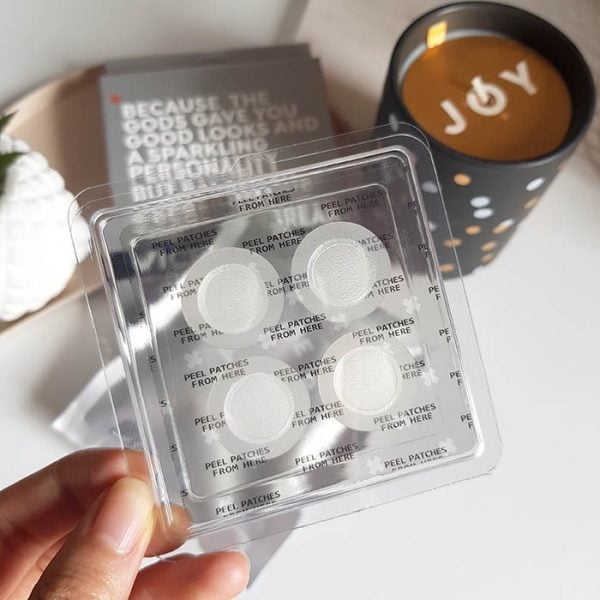
Acropass Spot Eraser and Zitsticka Hyperfade both have ascorbic acid in them, but it’s not really the star ingredient. These patches are only really good for acne marks, and also contain other pigment fading ingredients in them.
That’s a rundown of all the common ascorbic acid product categories I could think of – please let me know if I’ve missed any!
I’m going to go through vitamin C derivatives in part 2. Derivatives are good options if you don’t like the smell, staining or irritation of ascorbic acid, but you do sacrifice a bit of that guaranteed efficacy in the first column of the Lab Muffin Matrix.
References
This isn’t an exhaustive list, because it’s already an exhausting list to compile and format. If you’re after a reference let me know and I can try to dig it up… chances are it’s linked in the body of the article!
Kind of Stephen has a lot of posts on vitamin C (and other aspects of skincare) – the most relevant cover ascorbic acid and niacinamide and skin penetration of ascorbic acid.
Holy Snails C E Ferulic DIY Recipe
Easy (5 Minute) DIY Vitamin C Serum Recipe
Pinnell SR, Yang H, Omar M, et al, Topical L-ascorbic acid: percutaneous absorption studies, Dermatol Surg 2001, 27, 137-142. DOI: 10.1046/j.1524-4725.2001.00264.x
Colven RM, Pinnell SR, Topical vitamin C in aging, Clin Dermatol 1996, 14, 227-234. DOI: 10.1016/0738-081x(95)00158-c
Fitzpatrick RE, Rostan EF, Double-blind, half-face study comparing topical vitamin C and vehicle for rejuvenation of photodamage, Dermatol Surg 2002, 28, 231-236. DOI: 10.1046/j.1524-4725.2002.01129.x
Heber GK et al., An immunohistological study of anhydrous topical ascorbic acid compositions on ex vivo human skin, J Cosmet Dermatol 2006, 5, 150-156. DOI: 10.1111/j.1473-2165.2006.00242.x
This post is not sponsored, but many of the products mentioned were provided as PR samples for editorial consideration; however, these are still my honest opinions of the products. This post also contains affiliate links – if you decide to click through and purchase any product, you’ll be supporting Lab Muffin financially (at no extra cost to you), thank you! For more information, see Disclosure Policy.



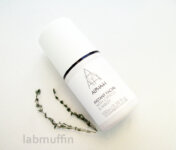
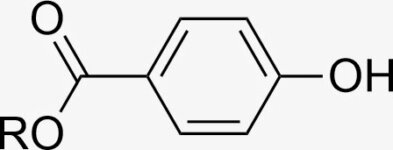
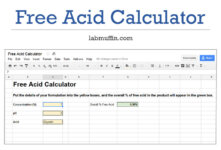
Thanks for this Michelle! Very useful.
Have you checked out the Exuviance vitamin C? 20% LAA, packed in separate doses?
Thanks in advance.
A great deep-dive Michelle! As someone who has dabbled with Vitamin C for a few years it’s great to finally have all the different uses and applications pulled together and explained in one place. There’s so much Vitamin C stuff out there that it’s hard to know where to start sometimes.
Hi Michelle!!!!!! Long-time supporter here, my first time replying though.
I’m not a scientist or researcher in any shape or form (I wish). But I love digging through Google Scholar and PubMed and read through academic papers.
Anyway, I’d like to add a few things as I’d come across them before.
1. The role of L-AA in skin lightening: “AsA interferes with melanin synthesis by reducing oxidized dopaquinone, interrupting DHICA oxidation and interacting with copper ions at the active site of tyrosinase. ”
Ebanks JP, Wickett RR, Boissy RE. Mechanisms regulating skin pigmentation: the rise and fall of complexion coloration. Int J Mol Sci. 2009;10(9):4066-4087. Published 2009 Sep 15. doi:10.3390/ijms10094066
This is interesting because I remember reading on UL Prospector that a formulator should always using a chelating agent (e.g., Sodium EDTA) in a vitamin C formula. The reason being apparently AA can chelate iron and copper ions in water, deactivating the AA. I don’t think we can visually detect whether this has occurred.
2. Dehydroascorbic Acid (DHAA) might work! It does penetrate skin apparently, and we know that DHAA can be recycled back to Ascorbic Acid by glutathione and other enzymes. The research may be lacking by your standards, but this is promising.
The paper also mentions only 12% of AA in a 10% solution penetrates the skin in 72 hours. About 50% of the vitamin C in our skin is in the form of DHAA.
Typically, vitamin C in our skin comes from diet. It’s oxidized to DHAA so it can be transported to cells across our body (SVCT and GLUT as transporters). When it reaches target cells, DHAA is immediately reduced back to AA.
However, this paper is sponsored by a company that makes DHAA-based face products, and looks sketchy so take it with a grain of salt.
Acid, M. R. T. A., & Kitt, D. Q. (2012). Topical Dehydroascorbic Acid (Oxidized Vitamin C) Permeates Stratum Corneum.
Curiously, Dr. Pinnell’s paper found that topical DHAA didn’t significantly elevate the AA levels in the skin. I feel that the DHAA section is too simple. We know that pigs can make AA but humans can’t, and that might explain why DHAA didn’t convert to AA, since the transportation of DHAA follows a concentration gradient (Wilson, 2002). Perhpas the cells decided they didn’t need vitamin C, so no AA was created.
Pinnell, S. R., Yang, H., Omar, M., Riviere, N. M., DeBuys, H. V., Walker, L. C., … & Levine, M. (2001). Topical L‐ascorbic acid: percutaneous absorption studies. Dermatologic surgery, 27(2), 137-142.
Wilson, J. X. (2002). The physiological role of dehydroascorbic acid. FEBS letters, 527(1-3), 5-9.
3. I *would* consider Drunk Elephant’s C-Firma sort of a copycat product. They did get sued by L’Oreal for having the CEF combo in 2020 (although C-Firma’s pH level *was* outside of the 2-3.5 range).
DE did something shady with C-Firma, specifically, masking the ongoing oxidation of L-AA (unavoidable) with the addition of Pumpkin Ferment, which is an orange-looking ingredient itself. This made it impossible to tell whether the L-AA went oxidized. So making the user mix it upon use is a good move.
4. I feel like vitamin E (Tocopherol) is underappreciated. In our skin, vitamin E, vitamin C, and glutathione are major antioxidants and they recycle each other, despite existing in different phases. It’s also lipid-soluble, so where AA penetrates slowly, vitamin E is readily available for the epidermis. Vitamin E also prevents DNA damage by inhibiting the formation of CPD as well as sunburn cells (SBCs) post-UV exposure. I can’t say enough good things about it.
Personally I try to use vitamin C products that have vitamin E in them rather than ones that subsitute it with something else, or ones that feature vitamin C solo. C+ E have great synergy.
This is a lot. Probably super overwhelming. Thank you for hard work!!!!! <3
I AM SO GLAD YOU SHARED ABOUT THE EYEBROW PENCIL. I havent worn any makeup for the last year and I just started using my normal eyebrow pencil again yesterday. I couldn’t figure out why my eyebrows were getting itchy, until I saw your blog post!!!
Note: i am using the grey Innisfree eyebrow pencil in grey. The other colours didnt have the ferric ammonium ferranocyanide.
Hello Michelle!
Would apply Copper peptides onto AM routine innactivate the vitamin C in my PM routine ?
I am a huge fan of Vitamin C serums and thankfully my skin has no issues with AA usually. I tend to not mix it with any other potentially irritating substances though as you mentioned, just in case it might burn off my face.
Fascinating reading 🙂 But poor pigs 🙁
Hi,
I noticed that you did not include Drunk Elephant in your list of dupes. I have seen many places that this was always the closest (and as evidence by lawsuits l’oreal thinks so too). Any reason for the exclusion?
They’re reformulating – the new version is included in the “partial DIY” section.
thank you so much! looking forward to part 2
Thoroughly enjoyed this post, Michelle! I’m a cosmetic dermatology nurse practitioner and founder of a beauty brand with clinics (BNA, ATL, DAL, CLT) and a skin care line.
We have a 10% ascorbic acid serum that comes with the liquid vehicle and active vitamin c separately packaged. The two are combined immediately prior to use to guarantee peak stability snd efficacy.
We’ve maintained the amber glass vial through our reformulating process, as we’ve found if the product is closed tightly and kept away from light (ie the Cuyana container) it does not oxidize.
It was really fun reading your article to gain further confidence in our product. I sent this to the rest of our team and plan to read more of your content today.
Hoping to connect in the future as two women in the medical skin care world!
Hey Michelle!
I am so grateful to you for all that you do! I trust you very much and would be happy if you could comment on the claims made in this article (more like a blog post): https://www.oumere.com/blogs/news/the-3-reasons-why-vitamin-c-serums-are-bad-for-your-skin.
Kindest regards,
Anna
I’ve addressed some of the claims before here: https://labmuffin.com/mythbusting-vitamin-c-serums-bad/
I’ve just tried Geek and Gorgeous’ C-glow vit C serum for the past 3 weeks. I have recently developed rosacea and was hesitant to try. I’m so excited I can tolerate and that it works. I’m in the UK and I got it white and fresh and almost went through half the bottle, using morning and night. I now reduced to morning to not overdo it but my skin is noticeably brighter and I get much fewer spots. For less than £12, this is a great deal.